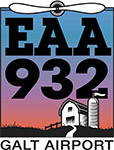Spring is finally here and not a moment too soon if you ask me. We are all tired of being cooped up in our houses and eager to get outside for some fun aviating with friends. To kick start the “flying season,” EAA Chapter 932 organized a fly out to Rochelle (RPJ), which was very well attended. They are now planning a second fly out from Galt (10C), this time to Prairie du Chien (PDC) for dinner at the fabulous Jones’ Black Angus Steakhouse, on May 15. The sun will set around 8:08 so you will be able to fly there in daylight and have a wonderful opportunity to get in a little bit of night flying on the way back.
A lot of pilots avoid flying at night, perhaps because the private pilot training only requires three hours of night flying and that is not enough to make most people feel comfortable and proficient. After passing the check ride pilots tend to fly mostly when the sun is shining because that is when most social activities take place and it’s what they most familiar with. Before long several years have passed and they find haven’t flown after sunset in all that time so now they are even less comfortable with the idea.
As with most aspects of flying, night piloting skills atrophy when not used for a while and it might take a little bit of effort to get up to speed on the particular regulations, techniques and systems you need to use at night. So, if you are one of those pilots who doesn’t regularly fly in the dark, here are a few tips on how to get ready for your next night flight:
- If your night currency has expired and you intend to take passengers you will need to get current ahead of time. You can do this solo, but if has been a very long time since you last flew at night it might be a good idea to fly with your CFI to brush up on those night landings. For night currency, the FAA says you need three takeoffs and landings to a full stop and they all have to occur between one hour after sunset and one hour before sunrise.
- Your preflight preparation for every night flight should include a review of everything you would normally investigate for a day flight but also cover airport lighting systems, especially how to operate pilot-controlled lighting systems, if available, equipment required at night, a flight plan using well-lit landmarks, plan for a 45 minutes or more fuel reserve and a obtain a good understanding of terrain and obstacle clearances along your route of flight.
- Additionally, you will want to pay special attention to the weather because conditions need to be significantly better to fly at night. For example, haze or low scattered cloud layers can easily obscure the horizon and flights over rural areas with few lights can also create dangerous conditions for VFR-only pilots.
- When flying at night, protect your night vision by avoiding white lights and using only red lights in the cockpit. You will want to lower the brightness of your (and your passengers’) electronic devices and avoid using flash photography. Protect other pilots’ vision by not using your strobe lights during taxiing and don’t taxi towards other aircraft on the ground or landing traffic with all your landing and taxi lights lit up.
- Remember to take at least two or more flashlights—you can never have too many flashlights—and plenty of spare batteries, and I highly recommend a headlamp with a red lens so that you can see and still have both hands free.
When you log your flight time as “night,” the FAA’s definition says night-time begins at the end of evening civil twilight, which is usually about thirty minutes after sunset. This means that on May 15th you will only be able to log time flown as “night-time” after 8:38 p.m.
If you needed a reason to fly at night, a group fly-out is just about the best opportunity there is to do that.

